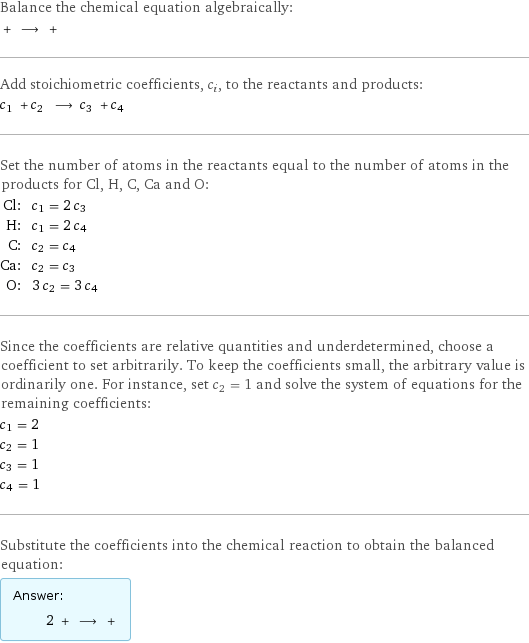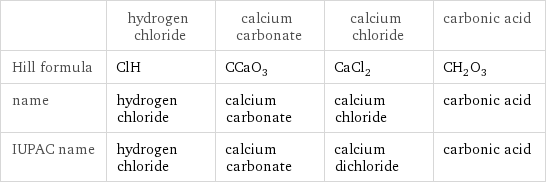Input interpretation

hydrogen chloride + calcium carbonate ⟶ calcium chloride + carbonic acid
Balanced equation

Balance the chemical equation algebraically: + ⟶ + Add stoichiometric coefficients, c_i, to the reactants and products: c_1 + c_2 ⟶ c_3 + c_4 Set the number of atoms in the reactants equal to the number of atoms in the products for Cl, H, C, Ca and O: Cl: | c_1 = 2 c_3 H: | c_1 = 2 c_4 C: | c_2 = c_4 Ca: | c_2 = c_3 O: | 3 c_2 = 3 c_4 Since the coefficients are relative quantities and underdetermined, choose a coefficient to set arbitrarily. To keep the coefficients small, the arbitrary value is ordinarily one. For instance, set c_2 = 1 and solve the system of equations for the remaining coefficients: c_1 = 2 c_2 = 1 c_3 = 1 c_4 = 1 Substitute the coefficients into the chemical reaction to obtain the balanced equation: Answer: | | 2 + ⟶ +
Structures

+ ⟶ +
Names

hydrogen chloride + calcium carbonate ⟶ calcium chloride + carbonic acid
Chemical names and formulas

| hydrogen chloride | calcium carbonate | calcium chloride | carbonic acid Hill formula | ClH | CCaO_3 | CaCl_2 | CH_2O_3 name | hydrogen chloride | calcium carbonate | calcium chloride | carbonic acid IUPAC name | hydrogen chloride | calcium carbonate | calcium dichloride | carbonic acid
Substance properties

| hydrogen chloride | calcium carbonate | calcium chloride | carbonic acid molar mass | 36.46 g/mol | 100.09 g/mol | 111 g/mol | 62.024 g/mol phase | gas (at STP) | solid (at STP) | solid (at STP) | melting point | -114.17 °C | 1340 °C | 772 °C | boiling point | -85 °C | | | density | 0.00149 g/cm^3 (at 25 °C) | 2.71 g/cm^3 | 2.15 g/cm^3 | solubility in water | miscible | insoluble | soluble |
Units
